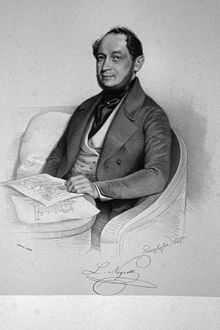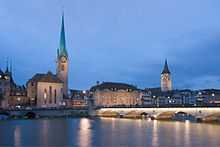Alois Negrelli


Alois Negrelli, Ritter von Moldelbe (January 23, 1799 - October 1, 1858), was an Austrian engineer and railroad pioneer in Austria, Italy and Switzerland.
Biography
He was born as Luigi Negrelli in the village Fiera di Primiero (Primör), in County of Tyrol (then part of the Austrian Empire - today Trentino, Italy), went to secondary school in Feltre and studied in Padua and Innsbruck,[1] then the capital of the Crownland of Tyrol. After beginning his career in Innsbruck, he lived for some time in Bregenz, Vorarlberg, Austria, where he earned a reputation in the channelization of the Alpenrhein and of the various Austrian and Swiss interests connected therewith.[2] He moved to Switzerland in 1832 where he continued similar works in the Canton of St. Gallen. In 1835, he was called to Zurich,[3] where he executed various works, notably the Munster Bridge together with Ferdinand Stadler who was responsible for the carpentry. Stone bridges were built over a wooden timber frame at this time. He also started to draw plans for the first Swiss railroad, the Swiss Northern Railway, from Zurich to Baden, which several years later were built under his supervision. During a journey to England, France and Belgium, he studied the new railways and subsequently published his ideas of adapting this technology to mountainous regions in some papers receiving wide attention in the industry.[1][4]
He returned to working for Austria in 1840, and until 1857 was inspector for the Austrian Northern Railway and the Austrian state railways. He was responsible for the construction of the railway from Vienna via Prague to the German border in the direction of Dresden and via Ostrava to the Polish border in the direction of Kraków and prepared the railway to the then Austrian Lviv and of the extension to the Russian border further east. He led the construction of the Negrelli Viaduct in Prague between 1846 and 1849. This railway bridge with its 1110 m was the longest bridge in Europe until 1910.[5] Negrelli's authority in railway matters was material in the making of the decision to have the Semmering railway built by Carl von Ghega and his advice on railway matters was requested by various other states like the Kingdom of Württemberg and the Kingdom of Saxony.[1]
In 1849, he was sent to the then Austrian Lombardy-Venetia, with the task of overseeing public buildings, railways and telegraph lines construction, and traffic on river Po.[4] During that time he received the title Ritter von Moldelbe, a name he chose himself in memory of his times working on the rivers Vltava/Moldau and Elbe.[3] He returned to Vienna in 1855 where he was appointed General Inspector of the Austrian railways.[4]
In 1846 he had been invited by Barthélemy Prosper Enfantin to the Société d'Études du Canal de Suez and took part in the exploration tour to the isthmus of Suez in 1847. In 1855 he was invited by Ferdinand de Lesseps to the International Commission for the piercing of the isthmus of Suez (Commission Internationale pour le percement de l'isthme des Suez) consisting of thirteen experts from seven countries who were to examine the plans already made by Linant de Bellefonds and to advise on the feasibility of and on the best route for the canal. Negrelli formed part of the surveying group travelling to Egypt. In the final deliberations of the Commission in Paris in 1856, his ideas of a canal without locks and a northern entry further to the west prevailed. The Commission then produced a comprehensive final report including plans and profiles according to which the Suez Canal was later built by the Suez Canal Company established in late 1858 by Lesseps.[6]
Negrelli was prevented by a serious illness from visiting Egypt another time and died in Vienna on 1 October 1858, some weeks before the Suez Canal Company was established and half a year before the works on the canal were started.[1]
In his book about Transportation in Egypt Negrelli wrote about the Suez Canal:
...The connection of the two seas with a canal is not only a necessity for free trade by shortening the route between Europe and the old rich countries of the Indian Ocean but also for increase of coastal navigation and economic prosperity of this blessed country (Egypt)... (eLibrary Austria Project (translated from the German text))
Works
- Ausflug nach Frankreich, England und Belgien zur Beobachtung der dortigen Eisenbahnen, mit einem Anhange über Anwendung von Eisenbahnen in Gebirgsländern, L. Negrelli, Oberingenieur der Kaufmannschaft in Zürich. Frauenfeld,1838
- Die gegenwärtigen Transport- und Kommunikationsmittel Egyptens mit Beziehung auf die beantragte Durchstechung der Landenge von Suez, Alois Negrelli von Moldelbe, 1856 ("Transportation in Egypt")
- Die Eisenbahnen mit Anwendung der gewöhnlichen Dampfwägen als bewegende Kraft über Anhöhen und Wasserscheiden sind ausführbar. Ein auf Erfahrungen begründeter und praktisch dargestellter Vorschlag. Beck'sche Universitäts-Buchhandlung, Vienna 1842
- Über Gebirgseisenbahnen, Vienna 1842
- Gutachten über den Bau einer obenfahrbarn Brücke über die Limmat in Zürich, eines neuen Kornhauses und Hafens, 1834
- Die Münsterbrücke in Zürich, 1844
References
- ↑ 1.0 1.1 1.2 1.3 Biographisches Lexikon des Kaiserthums Österreich
- ↑ Österr. Biographisches Lexikon p. 56
- ↑ 3.0 3.1 Wolfgang Bahr: Der Ingenieur aus Primör in Austria-Lexikon
- ↑ 4.0 4.1 4.2 Österr. Biographisches Lexikon S. 57
- ↑ http://www.pis.cz/cz/praha/pamatky/negrelliho_karlinsky_viadukt
- ↑ Percement de l'isthme de Suez. Rapport et Projet de la Commission Internationale. Documents Publiés par M. Ferdinand de Lesseps. Troisième série. Paris aux bureaux de l'Isthme de Suez, Journal de l'Union des deux Mers, et chez Henri Plon, Éditeur, 1856. Digitization on Google Books (French)
External links
| Wikimedia Commons has media related to Alois Negrelli von Moldelbe. |
- Alois Negrelli information at Structurae
|